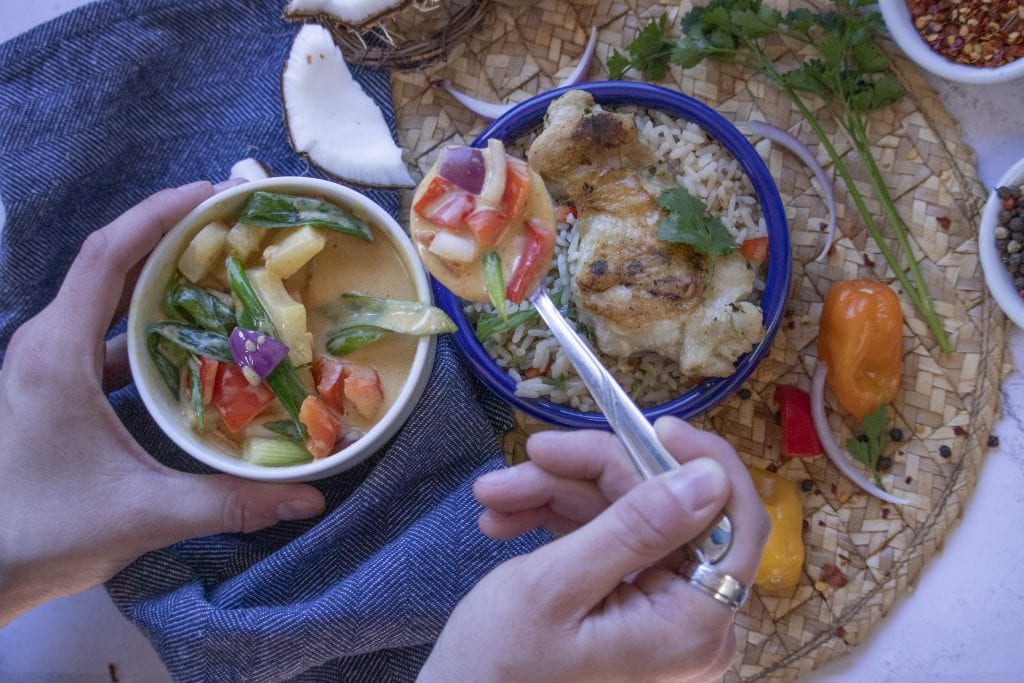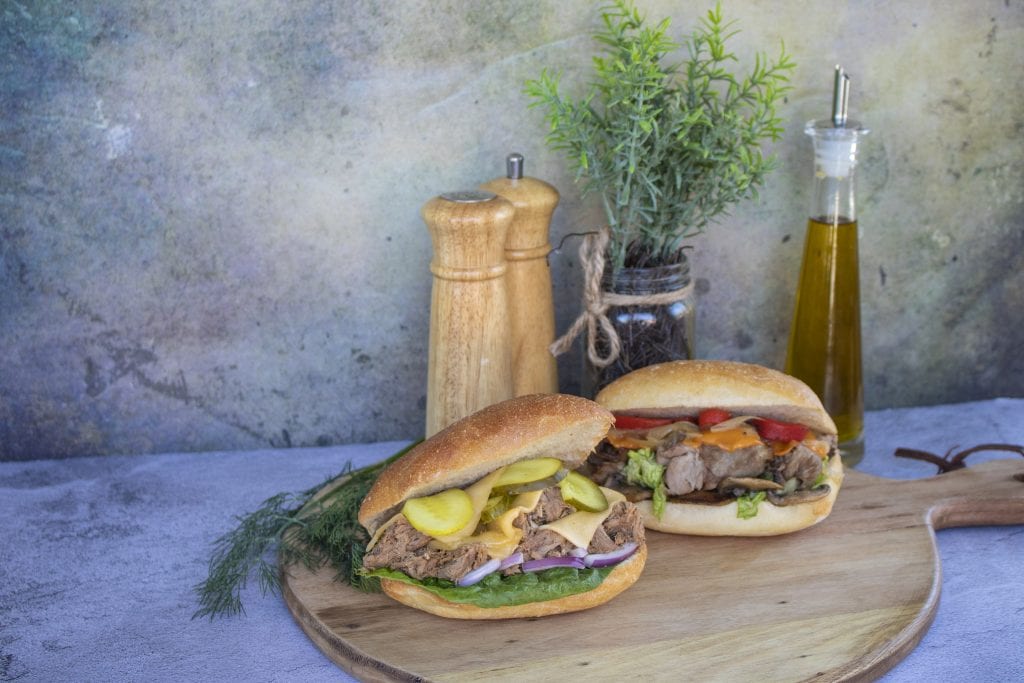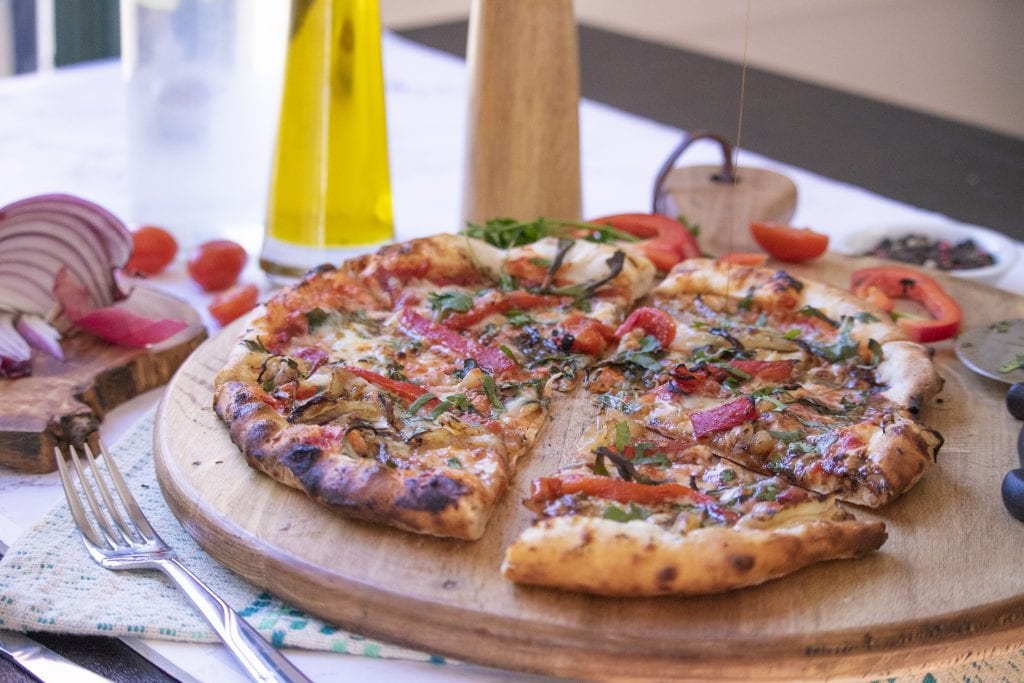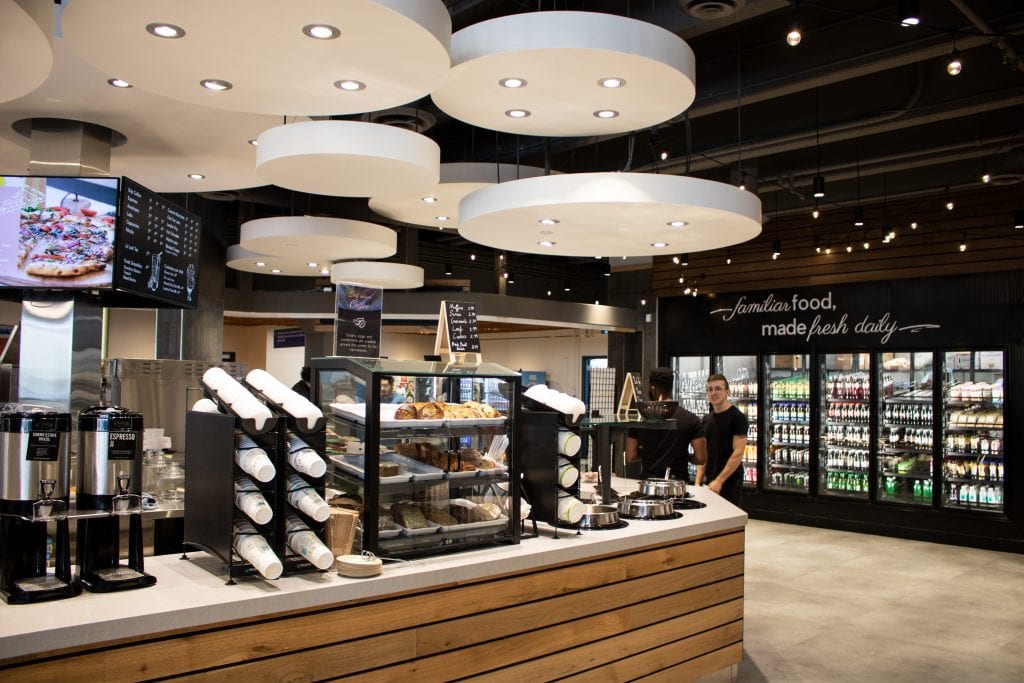Note to media: Photos of Pavilion available for download. Please contact Amy Chen for interview opportunities related to Pavilion.
BCIT and the BCIT Student Association (BCITSA) joined forces to open the latest campus eatery, Pavilion. Located in the NE1 building of Burnaby Campus, Pavilion is a fresh new destination providing unique menu items in an inviting and modern atmosphere.
Sit and enjoy a home-style meal like curry, grab a lunch to-go from the rotation selection of smoked in-house meats, or meet friends for JJ Bean direct trade coffee, menu items from Pavilion are familiar, freshly made in-house, and use locally sourced ingredients.
BCIT student Ali Pitargue sat down with Pavilion Head Chef Tannis Smith to dish about what’s hot on the menu.

Pavilion
Low and slow until it tenders—that’s how you cook a smoked brisket. It’s the superstar of barbecue meats, and godspeed to all who dare cook it under the sacred culinary traditions of Texas-style BBQ.
Luckily for us, Chef Tannis Smith is bringing her brisket-cooking prowess to BCIT. Her days working tailgate barbecues in Texas are over—now we’ll see her working the Burnaby campus’ new eatery, Pavilion, located in NE-1. The brisket will be part of its new line of hot carvery sandwiches. Pavilion officially opened its doors on April 29th, after pressure from the student body to diversify campus food options.
“Sustainability and innovation are key components of the new brand.”
Pavilion will have a rotating menu, including options for vegans and vegetarians, where students can set themselves up for something different to eat every day. The SA and BCIT planned this in hopes that it will transform into Burnaby campus’ new hot spot for campus food.
Students will get to feast on a wide selection of entrées and daily features. This ambitious menu includes hot carvery sandwiches, pizza, soup, salad, pasta, breakfast burritos, French toast, and a comprehensive beverage menu. Whether you’re in the mood for a cool salad during the summer or a hot chili later in the fall term, Chef Smith is keeping all of your cravings in mind.

“A new, modern kind of feel rather than stepping into an area that felt like a post-secondary cafeteria.”
Pavilion came together after much consideration about students’ dining interests. The SA and BCIT worked together to hire the right chef to lead it, to offer students a dynamic menu, and to keep in theme with BCIT’s edict for innovation.

The Chef who journeyed north
Pavilion’s new head chef—Tannis Smith—also happens to come from a polytechnic educational background. Before she decided to take up cooking as a career, she was studying bioengineering at MIT. And this has to make you wonder: what led her to cooking for BCIT?
It started with a change of heart.
Chef Smith was cooking as a part-time job while plowing through rigorous STEM courses at MIT. At one point, she actually planned on studying medical sciences, but it eventually dawned on her that she had to switch gears. As she was navigating that first career change, she took up cooking jobs with higher-end restaurants in Las Vegas. Chef Smith then found herself reviving a nostalgic kind of joy through this line of work; being a chef brought up old memories. It made her think back to the days when she was stirring gravy at her grandmother’s side when she was four years-old. From then on, it was clear: cooking was her life’s calling.
“I’m a double-dropout,” she laughs. “I fell in love with [cooking]. It’s what made me drop my career and change to it, because I found a new love.”
Cooking has since consumed Chef Smith’s life. Her home is designed like a restaurant kitchen, complete with fancy ovens, a smoker, backyard grills, and deep-fryers. She isn’t one to take breaks from her career. “In my spare time, I do dinner parties, or I’m in other people’s restaurants. Everything’s formed [around] the love of my life, basically.”
Tannis Smith grew up in an Italian-Ukrainian household, where she started getting acquainted with classic cooking at a very young age—pasta, perogies, and the like. “Before kindergarten, I knew how to roll dough,” she reminisces. “My little fingers did the perogies real nice.”
Chef Smith still cites Italian as her favourite cuisine.

She worked for a host of restaurants in the U.S. before making her way up north to Canada. When she came to Vancouver, she started by working for corporate chain restaurants like White Spot and Moxie’s, which ended up grooming her management and staff-training skills. Eventually, she made a transition to fine dining and started working for restaurants like Al Porto’s and CinCin.
Her career forced her to overcome her shyness, and she has since developed a strong personality herself, which matched up with what the SA was looking for in a chef. After undergoing a semi-Top Chef style ‘cooking interview’, she received an email from the SA saying she was hired. Mike Neal, the SA’s Director of Food Operations, approved of how Smith got things done.
“She’s had lots of experience in doing those different things,” says Neal. “It’s good to have somebody that’s keen and eager, that’s young and wants to deliver and execute this.”
Brewing up Pavilion
The concept of a collaborative food service was two years in the making, and it marks the first time that the SA and BCIT teamed up on a major construction project. With so many hands at play, one would think that there were too many cooks in the kitchen, but James Foran, the SA’s Director of Marketing and Communications, says that the collaboration was a fruitful one.
“It’s been very rewarding,” says Foran. “And luckily for me, I’ve worked with a great team.”
BCIT was also eager to join forces with the SA. Vince Laxton, BCIT’s Director of Corporate Services, had been mulling over the idea of a collaboration for about five years. Prior to Pavilion, BCIT Food Services had a direct competition model with the SA; each would set up shop in the same area to sell the same items like coffee and hot dogs. “It was just kind of the worst of both worlds,” says Laxton. “We had this vision to combine forces and do something really innovative that [would] benefit the whole BCIT community.”
The SA took the lead in conceptualizing Pavilion. The SA’s Director of Food Operations, Mike Neal, led the planning process. He and his team would drum up menu proposals and samples, while BCIT provided valuable feedback and suggestions. Neal says that BCIT is not a silent partner, and that their contributions have been valued.
Have you subscribed? Sign-up to receive the latest news on BCIT.
“We [the SA] are essentially the face that everybody would see,” explains Neal. “We are going to have signage up there that it’s a joint partnership [between BCIT and the SA], but we are the ones driving it.”
BCIT hired a consultant to assess students’ attitudes toward the current on-campus food options, and the students were generally dissatisfied. Whether it be the shortage of healthy options or the lacking quality of the food itself, Neal and the team knew that Pavilion had to differentiate itself. This meant gauging dietary trends and increasingly-diverse food palettes, as well as figuring out the logistics of adhering to those standards.
Jimmy Kim, BCIT’s Associate Director of Operations, says that they were intent on setting Pavilion apart from typical campus eateries. “We want to bring a venue that would very much be like what you’d see in Gastown or Yaletown,” explains Kim. “A new, modern kind of feel rather than stepping into an area that felt like a post-secondary cafeteria.”
Pavilion’s menu is largely Neal’s brainchild, but he worked with Tannis Smith to put those ideas into recipes. “Mike gave me a menu of about a hundred items, and said, ‘These are the thoughts I’ve been creating for a couple of years.’ I get to create the recipes and the flavours, he’s got the idea behind it.”

Neal took inspiration from the Vancouver sandwich franchise, Meat & Bread. “It has hot carvery sandwiches,” cites Neal. “So that sort of inspired me to create my own and pitch that concept.”
Pavilion’s sandwich ingredients are going to be made in-house, which will set them apart from other food options. Instead of summoning outside suppliers, making food in-house affords them the ability to control the quality of their product. Tannis Smith attests to this. She says she prioritizes the quality of food above all else, and that can be achieved by cooking from scratch. “It’s really easy—especially if you’re really busy and you don’t have help—to just cut corners and say, ‘oh, let’s just get pre-roasted roast beef and heat it up and make a sandwich out of that.”
Smith is an admitted meat-lover, but vegetarian and vegan alternatives are one of the most requested food items from student surveys. Green food consumption has grown more commonplace in recent years, and for Smith, it is imperative for chefs to get with the times.
Adopting healthier food in her menu was eye-opening for her. “You need to learn it. The trends are changing. People’s diets are changing and evolving, so it’s something that we’re really happy to focus on.”
Neal says that Pavilion’s vegetarian and vegan menu has yet to grow. “We currently have a very limited number of vegan and vegetarian items,” he admits. While Pavilion is not going to have an overabundance of vegan and vegetarian options, it will have plenty more than what other food outlets on campus are offering.

Variety and quality are key goals of the Pavilion project. They are looking to roll out hundreds of new food items made with carefully-sourced ingredients. You’re likely thinking to yourself: ‘This all sounds fancy, but how exactly will Pavilion provide this food without forcing students to dig hard into their pockets?’
Don’t fret, the SA also kept your wallets in consideration. When they kickstarted the Pavilion project, both the SA and BCIT knew they had a challenge. They had the daunting task of conceptualizing a food services operation that not only caters to different food preferences but also remains considerate of students who have a limited budget. This means striving for high-end tastes that typical student patrons can find affordable.
“That’s what we are trying to be to students,” says Neal. “Offering them fair pricing, good quality products, and we’ll see how that evolves and goes, but that’s what it’s built on.”
Smith advises that having bigger quality control of ingredients and making food in-house will actually cut down costs, not increase them. This avoids all the hefty price negotiations with suppliers.

A typical entrée, such as the aforementioned hot carvery sandwich, will be priced around 9 to 10 dollars. Pavilion’s pricing makes an effort to reflect or be less than what the outside market offers. Whether the student body finds these items affordable or not, the team hopes that the quality of the products will make a good bang for your buck.
An eco-friendly approach
Sustainability and innovation are key components of the new brand. This is why James Foran, as the SA’s Director of Marketing and Communications, and the rest of the Pavilion team saw the creation of Pavilion as an opportunity to raise the bar. They are rolling out compostable packaging products for most of the in-house foods that Pavilion is going to offer.
“We had a mandate from our previous board that we wanted to do this ethically and sustainably,” says Foran. “And one of the ways we can do that reduces our ecological footprint by having a compostable packaging.” Foran is in charge of putting forth appropriate brands, signs, and packages; and for the SA and BCIT, this means that the branding has to indicate that it’s ahead of its game.
The biggest challenge on Foran’s part is sourcing. Compostable and biodegradable products are not the industry standard at the moment, and in order to opt for this eco-friendly approach, they had to adhere to a premium. BCIT agreed with Foran and his team’s decision to make Pavilion’s operations environmentally-conscious. “BCIT knows that there are positive spill-over effects by taking this kind of approach. So, they’ve been very supportive of the whole process.”
Jimmy Kim says that BCIT holds similar goals for sustainability. From day one, they were onboard in implementing compostable and biodegradable products, especially since they’ve already started with their own food operations. “There’s been a lot of changes [in BCIT’s waste management] and a lot of pushes for BCIT to be a forefront leader in [sustainability].”
To satisfy their objectives—while keeping budgetary constraints in mind—Foran and his team had to conduct plenty of research on different providers and test different products. At the same time, they are also promoting the use of reusable items like mugs and bags. “We’ve taken every opportunity, looked at it and analyzed where our waste is created and where there is opportunity to improve upon.”
After Pavilion opens, the SA is not looking to stop improving upon their sustainability efforts. They recognize that the demand to grow more sustainable is constant. Hence, in true BCIT fashion, they want to stay on top of industry trends to make sure that they are getting the best compostable and biodegradable products they can find.

All the work put into Pavilion—from hiring the most skillful and suitable chef to sourcing sustainable capital—has all come to fruition this April. It’s doubtful that this project will turn out to be a flash in the pan, but in the end, that’s for the students to decide.
(With words by Ali Pitargue and photography by Emma Schram, Wafé Gara, and Eric Li via BCIT LINK)
SEE MORE: BCIT opens Summit Centre: a one-stop shop for entrepreneurship
